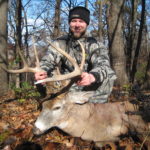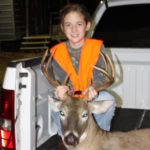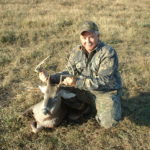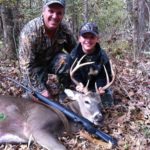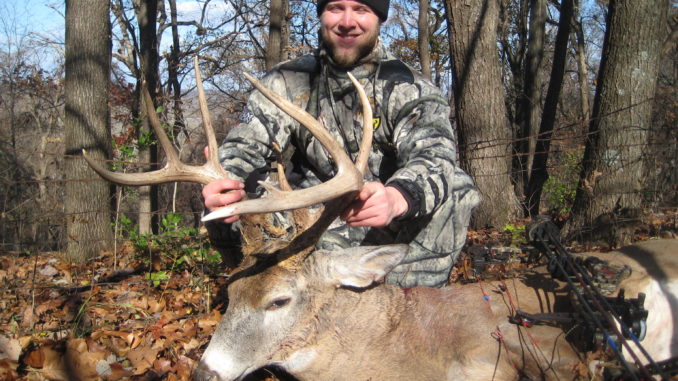
If you hunt North Louisiana and you think your best days for this season are behind you, you couldn’t be more wrong.
In the northwest corner of Louisiana, Red River bass fishing guide Russ McVey sits in a box stand overlooking a pipeline with his daughter Madison about to run out of iPod battery. They hope a buck trying to recover from the rut wants to grab a few kernels of corn.
One hundred miles to the east, University of Louisiana-Monroe finance major Jayson Calhoun, smelling like the scent line he drug on his way in, rides a swaying tree trunk in his climber. He hopes a buck crosses the road that divides his lease from his buddy’s to look for a doe that to this point has gone unbred.
The only thing McVey and Calhoun have in common is that they are both deer hunting North Louisiana during January.
Everything else about the way they hunt is different.
McVey puts out corn the day before he hunts with a spreader attached to his ATV, whereas Calhoun sneaks in without a smell or a sound to spread some rice bran, and he gets out just as quickly as he got in.
McVey hunts bucks that he assumes are finished with the rut, while Calhoun hunts bucks that he knows still have a little bit of a twinkle left in their eyes.
McVey routinely makes shots up to 300 yards with his .300 Winchester short mag, but Calhoun doesn’t take any shot much longer than 30 yards with his compound bow.
In the end, it really doesn’t matter how differently these two hunters hunt deer in North Louisiana because both have successfully scored on big bucks during January when many hunters may have mistakenly believed that it’s time to move on to other endeavors.
And as long as you hunt somewhere along the I-20 corridor, both of their approaches to hunting during January can pay off. However, it’s up to you to get out in the woods to see which approach works best on your deer.
McVey’s KISS spproach
“Our deer are gun-shy by this time of year,” McVey began, “and they’re hiding in any little nook and cranny they can find during January — at least until it gets dark.
“I like to keep it simple and hunt the pipelines, but if it’s windy, I will get back in the woods.”
The main reason McVey likes to keep it simple is because he’s into deer hunting so he can take his daughters hunting. Since he can’t really put either one of them up a tree back in the woods, he finds himself more frequently hunting the pipelines.
And since he believes the bucks crossing his pipeline are looking to eat to regain strength lost during the rut, McVey obliges them by putting some corn on the ground.
“It’s all a cat-and-mouse game this time of year,” McVey emphasized, “but where I hunt, they get on the corn pretty good in January, especially if it’s really wet and all the acorns left on the ground have soured.
“These pipelines up here can get a little hectic with all the hunting and four-wheeler riding, and it sounds like a war zone from all the duck hunters on Lake Bistineau every morning, but they give my kids and me our best chance for seeing deer.”
In fact, McVey’s daughter Madison killed a 9-point buck on a pipeline recently. Although he din’t expect much since he had just killed a little 2 1/2-year-old 8-point the day before, McVey was happy to see a monster of a deer step out in the pipeline about 20 minutes before dark.
“He was eating on some corn and presented her with a perfect broadside shot,” McVey said. “She double lunged him at 80 yards.
“And just to show you how good pipelines can be, three more deer stepped out right behind this one right after he went down.”
Not just any old pipeline will do, though, according to McVey. The ones he hunts with his daughters are positioned between bedding and feeding areas, and McVey has three well-worn trails that cross the pipeline within 300 yards of his box stand.
“If you can find this kind of set-up between maybe a pine thicket or cutover where they’re bedding and where they’re feeding, you’re on a pretty good spot for January up here in Northwest Louisiana,” he said. “Since they’re mainly finished with the rut, it’s almost like hunting the early season somewhere between their beds and their food.”
Although he believes deer that cross his pipeline are headed to a food source, McVey sweetens his pipeline opening with the aforementioned corn. But he doesn’t just rip open a bag and pour it on the ground. In fact, he doesn’t even sling it around by hand. Rather, McVey spreads his corn with an ATV spreader.
“I used to have feeders, and I would get a ton of pictures of deer on them, but they were all at night,” he said. “It was like they knew the feeder went off and there was corn on the ground, but they wouldn’t come out on it until dark.
“Deer that have grown up on those feeders don’t care because they’re programed to accept them, but a buck that’s never eaten off one, he ain’t going to that thing during the daytime.”
McVey feels his four-wheeler spreader actually saves him money when it comes to buying sacks of corn all season long. With one 50-pound bag of corn, he can go down the pipeline three our four times over the weekend.
“I generally throw it out on Thursday and hunt it Friday evening and Saturday morning,” McVey explained. “Then I can throw some around noon on Saturday and hunt it Saturday afternoon and Sunday.
“Just remember, deer are grazers, so I don’t recommend piling it up. They’re going to eat while they move.”
As for the four-wheeler noise, McVey hasn’t found it to be a problem in a region of Louisiana where more people have ATVs than have cars and trucks. People constantly ride four wheelers day and night, and McVey believes that means the noise doesn’t bother them nearly as much as it would some place where there aren’t a lot of ATV riders.
Calhoun’s second rut
On Jan. 1, Calhoun climbed into his stand expecting to find a deer or two coming to eat some of the rice bran he had put out a few days before. The surrounding timber was low on groceries, and the acorns on the ground had soured from being wet.
“I heard something coming, and it wound up being a buck headed right to the rice bran,” Calhoun recalled. “But then I suddenly realized that he wasn’t there to eat.
“He threw his head up and looked toward where the does usually come from and took off grunting.”
Calhoun was thinking that it was way too late for deer to be rutting in his little section of North Louisiana, but then he started remembering that he had captured some trail-cam images of does with spotted fawns around the first week of bow season.
“That’s when I realized that my lease, which is separated by my buddy’s lease by a road, was holding does that didn’t get bred during the main rut around Thanksgiving week to the first of December,” he said. “I climbed back in that evening, and that same buck came back to check the rice bran for does.
“That’s when I shot him.”
One of the variables that can suppress the rut is warm weather right when the deer are supposed to be breeding. The warm weather kind of shuts down the does, and they don’t get up and move around as much. In Calhoun’s opinion, 80-degree days during the middle of the rut are what trigger a second rut during January.
“And I’ve got some small does on my property,” Calhoun said. “I think those small does come into estrus way later than regular adult does.
“Then those young does have their fawns late, and they continue the cycle of coming into estrus later. It’s not even weather-dependent at that point.”
To better hunt bucks that have heard more gun fire than they care to, Calhoun has adopted a self-imposed archery-only philosophy on his 80-acre lease. It is only a part of his low-impact approach to hunting that pays off big time once the best part of the season rolls around.
“First off, I leave it alone until Thanksgiving week when the first rut usually begins,” he explained. “I
get out about the first week of December and stay
out until the last week of December.
“Then I hunt on into January, what I call the
second rut.”
Calhoun doesn’t go into his lease except to check cameras and put out rice bran, and then he goes in exactly like he’s hunting by getting as scent free as he can possibly be.
“And I don’t go in when the wind is blowing into the bedding area,” Calhoun said. “One thing I’ve learned is that a big buck just won’t put up with human scent.
“They see you in the stand, and they’ll come back the next day. But if they smell you — forget about it.”
And to top it off, the reason Calhoun uses rice bran instead of corn is that he feels corn can be like a red flag to pressured deer, especially big, mature bucks. To him, it’s all about hunting pressure. If deer associate corn with danger, or even rice bran for that matter, they aren’t going to come to it except at night.
“All deer are different, but I’ve definitely got a second rut on my property,” Calhoun said. “And my ultimate goal is to make those gun-shy big bucks come on over to my side and feel as safe as they can be.”
As Calhoun mentioned, all deer are different, and they inexplicably do things on one property that they don’t do at another property five miles up the road. Therefore, there are no guarantees you can go out and kill big bucks exactly like these two hunters do.
However, if you use their ideas as a starting point and adapt them to fit your own deer herd, you’ll find that the one thing you do have in common with McVey and Calhoun is that you, too, can successfully score some big January bucks.
